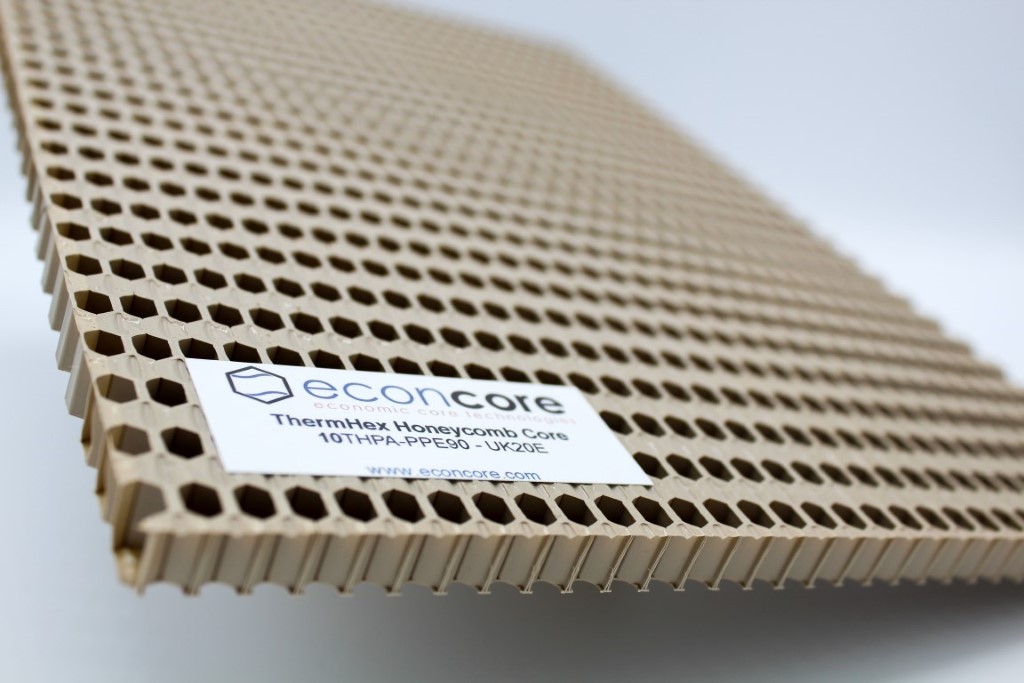Where collaboration meets innovation
SABIC’s Luc Govaerts, director of formulation & application development, Specialties business and EconCore’s chief operations officer, Tomasz Czarnecki discuss the synergy of the companies’ material and process technologies for new honeycomb structures that combine significant weight savings, thermal stability, rigidity and insulation capabilities.
Breakthrough advances in composites require close collaboration between players along the value chain. SABIC, a global diversified chemicals company, and EconCore, a global leader in honeycomb technologies, have joined forces to unlock the high performance potential of engineering thermoplastic honeycombs in important new application areas, such as e-mobility and photovoltaics.

The new honeycomb structures combine SABIC’s NORYL GTX resin, a polyphenylene ether (PPE) blend with polyamide (PA), and EconCore’s patented ThermHex technology to produce lightweight laminated sandwich panels with a very attractive cost/performance ratio over honeycombs made with different thermoplastic materials, such as polypropylene and polyamide. The PPE blend has a proven history in high-heat automotive applications, such as in-line painted body components. In honeycomb cores, it enables higher lamination temperatures and enhanced rigidity, while also offering excellent acoustic and thermal insulation properties. In addition, compared to many other types of polyamides, it minimises the water absorption of the structure, which adds to its superior dimensional stability.
The honeycombs can be directly laminated with compatible thermoplastic skin materials, including PA with or without glass fibres, resulting in an all-thermoplastic solution that eliminates the need for adhesives and provides efficient formability. For instance, these sandwich panels can easily be compression moulded into finished parts with complex geometries at relatively short cycle times. Moreover, made exclusively with thermoplastics, they facilitate both post-production as well as end-of-life recycling. The technology also allows the use of the more traditional thermoset-based reinforced skins.
A sustainable choice
The new honeycomb structures are targeted especially at demanding applications in e-mobility and renewable energy, but can also open significant light-weighting opportunities in other industries, including general automotive, mass transportation and building & construction. Typical applications are seen in thermally stable battery housings and ‘silent’ acoustic insulation designs for electric vehicles (EVs) as well as in high-heat resistant photovoltaic panels. The honeycomb design adds inherent thermal insulation properties, and thanks to their high stiffness, the NORYL GTX-based panels also have an immediate fit e.g. as vibration dampening substrates bonded to the inside of automotive body panels, especially within components that require elevated temperature resistance such as for example the hoods.
In all these applications, the thermoplastic honeycomb panels deliver important weight savings, which makes them a very sustainable material choice particularly in automotive and transportation. Their weight-out potential can not only help reduce fuel consumption in combustion vehicles, but also extend the reach of EVs where the higher mass of battery modules must be mitigated. In addition, the lower raw material usage of the honeycomb laminates compared to monolithic structures contributes to minimising fossil depletion.
High thermal stability
At the same time, the PPE-based honeycomb exhibits high load-bearing capacity even at temperatures up to 180°C. If required, this also makes it an ideal candidate for lamination with thermoset prepregs in processing environments where elevated curing temperatures are applied. SABIC’s NORYL GTX resin features heat deflection temperatures of up to 240°C, well-proven in in-line and powder coated automotive body panels. It shows lower water absorption and has a lower density than other engineering plastics, including polyamides, which can provide further weight savings without compromising dimensional stability.
Besides high rigidity and high heat resistance, the core material also lends honeycomb structures excellent impact resistance, with high energy absorption capability over a wide temperature range. SABIC is currently developing a specific new grade designed to extend the low temperature impact performance of the material to -30°C for enhanced EV battery protection.
In terms of processability, the PPE core material also ensures the high consistency and process stability required for efficient sheet extrusion, essential in manufacturing the honeycombs.
A manufacturing first
EconCore produces its honeycombs from a single continuous thermoplastic sheet using its patented ThermHex technology. In this unique process, the core material is processed in successive in-line operation steps, from extrusion to subsequent thermoforming into a half-hexagonal web which is then directly folded to result in the three-dimensional honeycomb structure. The flexible process can be used to produce a wide range of different honeycomb configurations in terms of cell size, core thickness and density.
Fully integrated production lines may also integrate the final lamination of the desired skin layers. Altogether, this opens very competitive and cost-efficient opportunities for continuous manufacturing of value-added laminated sandwich panels without the need for secondary operations. The company has licensed the technology to various leaders in automotive, transportation, B&C and packaging.

Industrial collaboration
Composite materials have emerged as a highly attractive option for light-weighting and metal-to-plastic conversion. However, their adoption in some more conservative industries and high-performance application areas with safety-critical requirements is associated with long development cycles to make sure that all industry standards and regulatory approvals are met.
In order to address these needs more effectively, SABIC and EconCore have teamed up to optimise and commercialise the new NORYL GTX-based honeycomb technology. Throughout their close collaboration in more than five years, they have built a solid database of suitable material options for honeycomb applications in various different industries, including mass transportation and aerospace. The successful implementation already includes honeycomb structures made with other engineering thermoplastics, such as polycarbonate (PC) and polyetherimide (PEI) resins.
One of the key advantages of honeycomb laminates is that they separate the structural demands to be met by the core material from the aesthetic requirements to be met by the outer skin, which results in a wide range of potential material combinations to satisfy different cost and performance regimes. The feasibility of extending the core material options to PPE blends has been confirmed in extensive testing, including dynamic thermo-mechanical analyses and processing trials. The resulting data helps accelerate the innovation of light-weighting applications, including in less traditional areas.
By combining EconCore’s extensive know-how in honeycombs with SABIC’s expertise in advanced PPE-based engineering thermoplastics, a new range of honeycomb cores and laminated composite panels has been developed to provide an outstanding weight/performance ratio over more traditional honeycomb structures. The thermoplastic core material provides higher thermal and dimensional stability, outstanding rigidity and lower water absorption, and the unique continuous manufacturing process adds cost-efficiency, flexibility and consistent product quality.
The synergy of both technologies opens new market and application opportunities, such as in e-mobility, photovoltaics and transportation. Together with compatible skin materials, an all-thermoplastic honeycomb structure can be created to meet ambitious targets of sustainability, including lower material consumption and recyclability.









